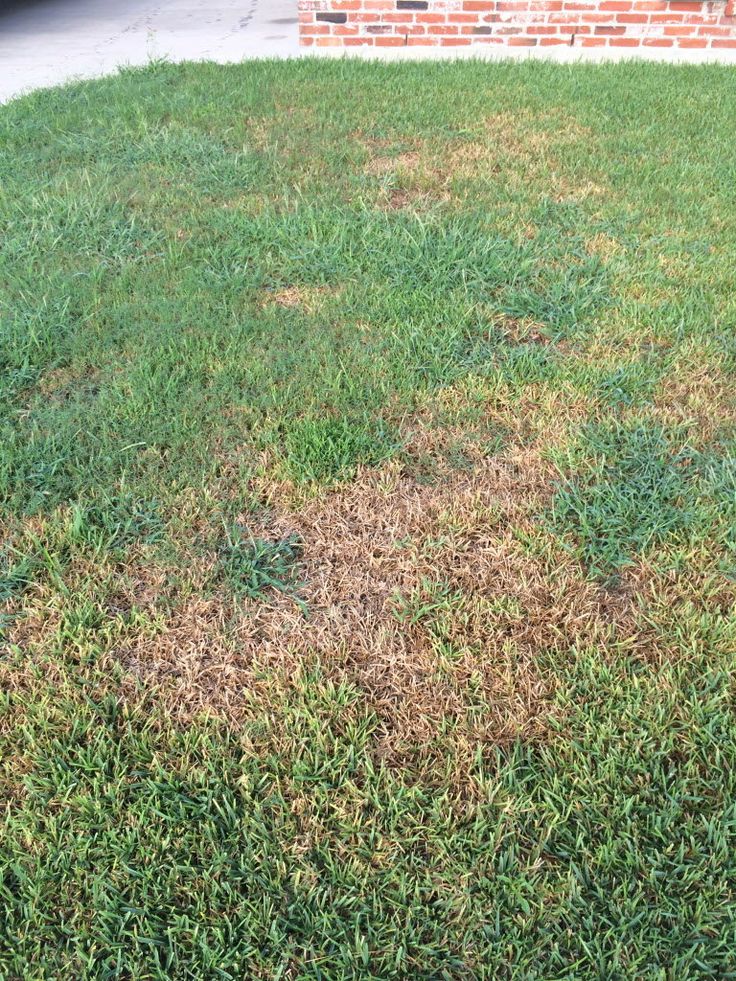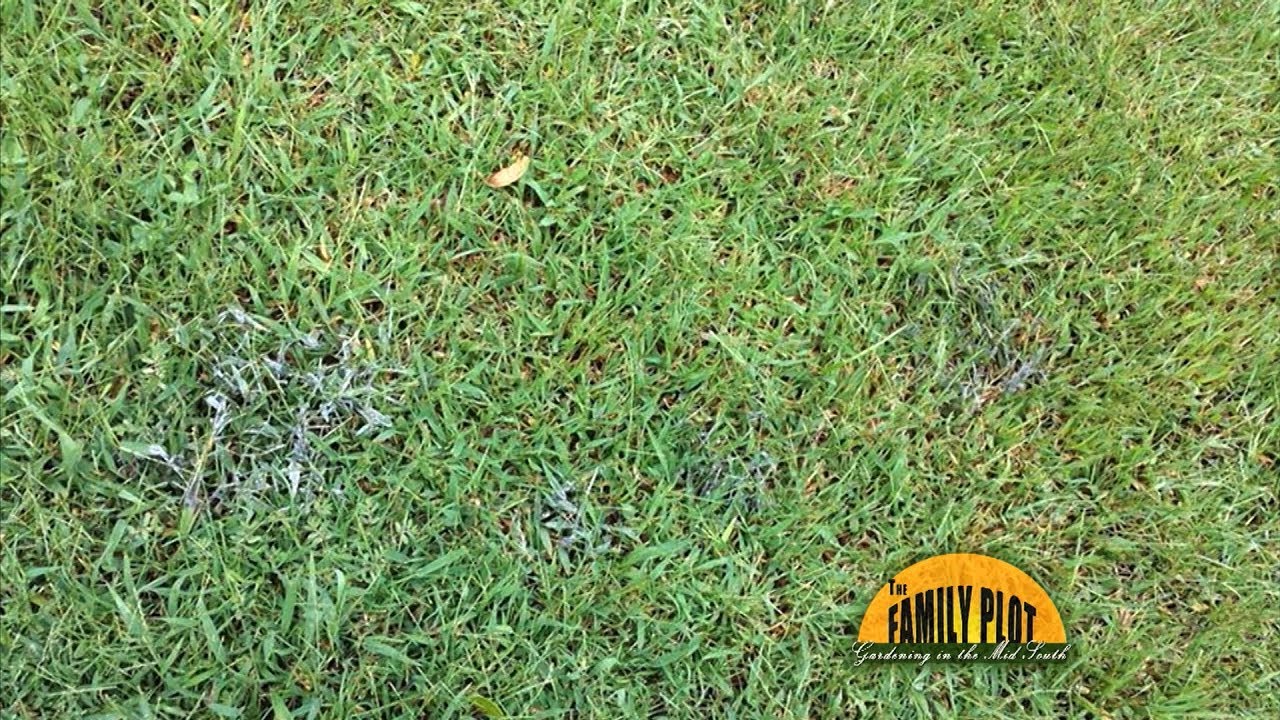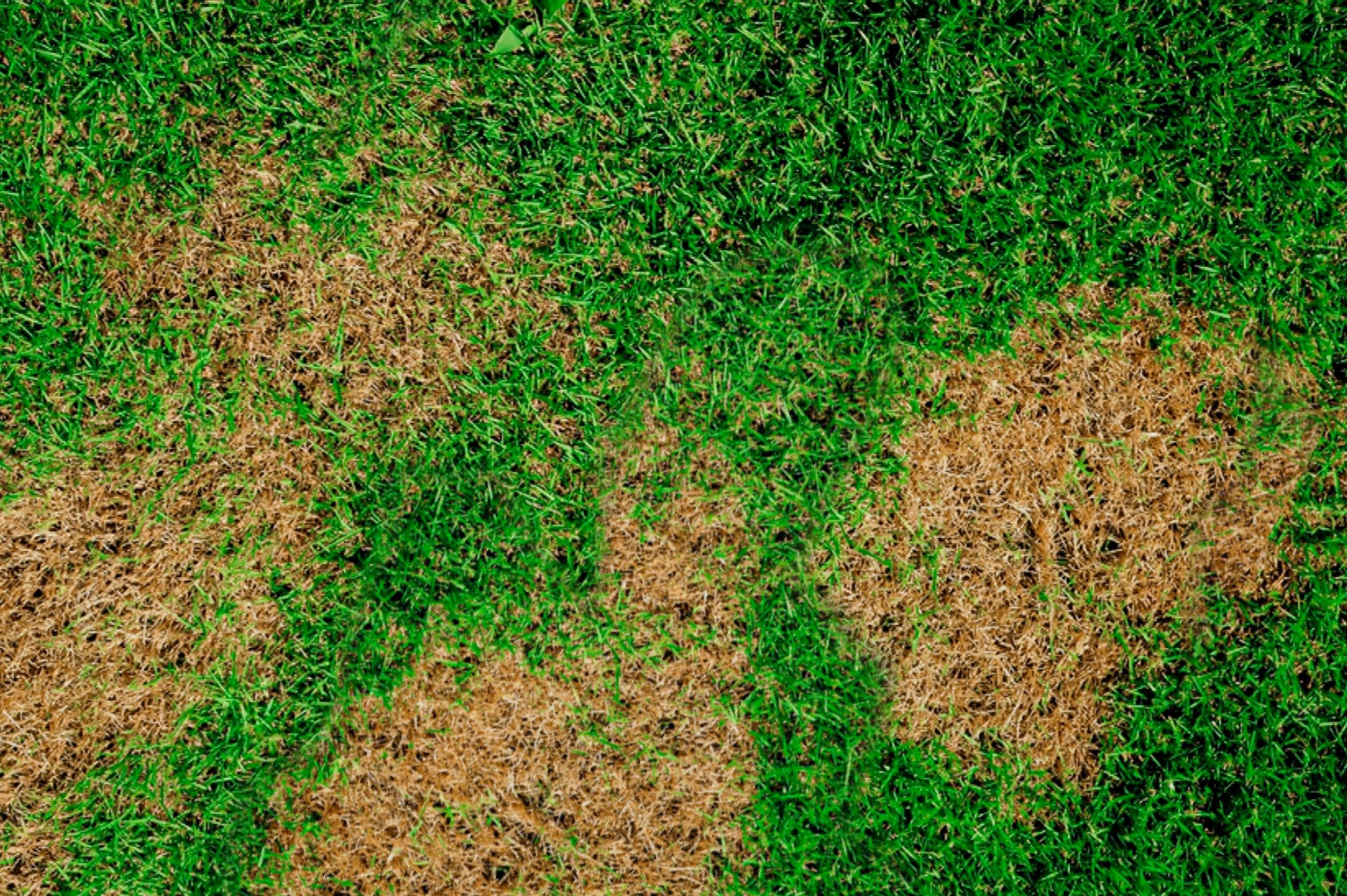What Causes Grass Fungus
Fungus is an active microorganism that can be found naturally on lawns. Some of them are quite harmless and contribute to the wellbeing and growth of your grass by supplying nutrients.
However, under the wrong conditions, these fungi can cause diseases that lead to the disruption to the growth of your grass. Some of the common causes of grass fungus I have noticed include:
Natural Remedies For Lawn Fungus
There are many natural remedies for lawn fungus. These include baking soda solutions, neem oil, and compost teas. For the best results, you should use these natural options early in the season as a preventative rather than waiting to treat your lawn after you already have a fungus.
Neem Oil
This is one of the better natural solutions available. Dilute 2 oz of neem oil into 1 gallon of water. Apply 2.5 gallons of the spray solution per 1,000 sq ft. You will typically need to apply this solution two or three times on a 7 14 day interval to ensure effective control.
Baking Soda
Using a weak baking soda solution to treat lawn fungus issues can be effective but you must be cautious. Baking soda is a salt and like all salts, can damage your lawn.
Grass type and environmental conditions such as rainfall, air temperature and lawn stress all affect how your grass reacts to the baking soda, so you run the risk of doing more harm than good.
Compost Tea
While the use of compost teas are generally considered a good way to increase the organic content of your lawn, research on using them as a natural fungicide is limited. When applied in the spring, compost teas will help to boost the overall health of your lawn and can help your lawn to be less susceptible to getting a fungus in late spring or summer.
However, compost teas alone are usually insufficient in preventing turfgrass diseases.
Clove Oil
How To Identify Lawn Fungus Diseases
Its not always easy to tell whether or not your lawn has a fungal disease or if theres some other issue. However, most fungal diseases have tell-tale signs that will tell you whats going on.
Some signs that your grass may be dealing with a fungal disease are:
- Patches of grass that are white, yellow, brown, or slightly gray in color that are growing in diameter. Or, patches of frayed, mangled, or dried out grass blades.
- Possible diseases: Brown patch disease, summer patch disease, rust lawn disease.
There are other fungal diseases that we havent listed that may be a little less common. Consult a lawn care professional for a diagnosis!
Also Check: How Does Nail Fungus Treatment Work
What Natural Home Remedy Will Kill Grass Fungus
17 July, 2017
For many people, keeping a green, uniform-looking lawn is important. A solid sheet of grass is not a natural environment, however, and invasive plants and organisms are constantly trying to break it up. Many varieties of fungus can appear in lawns, but a number of natural home remedies can alleviate problems associated with grass fungus. Some types of fungus can cause diseases in your yard, but treatment with fungicide is not recommended.
The Value Of Mushrooms

Fungi actually serve an important purpose in the garden by digesting decaying organic matter and providing nutrients to the surrounding soil and plants.
In addition to providing important nutrients, this function is key to preventing organic matter from piling up.
In ideal conditions, happy and thriving fungi will sprout mushrooms, which are actually the fruiting bodies responsible for the propagation of spores. This is sort of like a dandelion puff with all of its seeds.
Recommended Reading: What Gets Rid Of Toenail Fungus Naturally
How Do You Treat White Fungus On Houseplants
Combine one tablespoon baking soda and one-half teaspoon of liquid, non-detergent soap with one gallon of water, and spray the mixture liberally on the plants. Mouthwash. The mouthwash you may use on a daily basis for killing the germs in your mouth can also be effective at killing powdery mildew spores.
Dont forget to share this post
References and Further Readings :
How Many Times To Spray Lawn Fungus
The weather conditions will determine the exact answer to this, however, in general, most lawn fungicides need to be applied every 14 to 21 days throughout the most active growth period for the lawn fungus youre dealing with. Most lawn fungus infections occur in the late spring and the summer but this is, again, weather dependent. Fungus spreads rapidly in hot and wet conditions.
You May Like: How To Cure Fungus On Big Toe
Have You Noticed A Yellowish
Grass rust is a common visitor to residential lawns beginning in August and persisting through the fall months. It is a fungus that feels right at home when visiting stressed Kentucky bluegrass and perennial ryegrass in the North and tall fescue and zoysiagrass in the mid-South. No need to sweat, its generally just a nuisance and causes no serious damage to your lawn.
Can I Put Vinegar In The Dishwasher
To make a fungicide out of this, take one tablespoon of vinegar and mix it with a gallon of water. Shake this well and add to a spray bottle. Vinegar mixture can treat most fungal infections on any plant, without causing any harm.
Thereof, How do you get rid of plant fungus?
Make a typical baking soda spray by dissolving 1 teaspoon of baking soda into one quart of water. You can add a few drops of insecticidal soap or liquid soap to help the solution spread and stick to the leaves. Only use liquid soap, like Ivory, and not laundry detergent.
Also to know is, How do you get rid of plant fungus naturally? Make a typical baking soda spray by dissolving 1 teaspoon of baking soda into one quart of water. You can add a few drops of insecticidal soap or liquid soap to help the solution spread and stick to the leaves. Only use liquid soap, like Ivory, and not laundry detergent.
Subsequently, question is, How do you get rid of white fungus in soil? Soil sterilization helps control white fungus in warm climates. Prepare the soil for planting, including removing plant debris and tilling. Rake so the soil is as flat as possible. Water so the soil is moist to a depth of 12 inches, and then cover the entire area with 0.025 to 0.4 mm clear plastic sheeting.
Also, What causes fungus on indoor plants?
Read Also: What Gets Rid Of Toe Fungus
Common Lawn Fungal Diseases
There are quite a few fungal diseases that can impact lawns, but theyre usually pretty specialized, targeting specific lawn types, at certain times of year, under certain conditions. For example:
- Brown patch strikes during hot, humid weather.
- Fusarium blight prefers hot, drought conditions.
- Dollar spot tends to spring up when nights are cool and dew is heavy.
Before treating your lawn, its important to identify not only whether your lawn indeed has a fungal disease, but to identify the fungus itself. All fungicides arent the same, and some diseases can be easily treated by making changes in your lawn care.
Knowing your grass type and recent weather conditions can make it easier to narrow down, but you may need help in figuring out exactly whats going on. Your local cooperative extension center is your best resource for determining which diseases are most common in your area, or you can take a small baggie of the infected grass to your local garden center for help.
Use The Right Lawnmower Setting
Although short grass tends to be inhospitable to toadstools, we do not recommend cutting your grass too short. After all, you want a healthy and lush lawn. Try cutting just about 1/3 of the height of the grass and leaving the rest intact. Ensure that the blade of the lawnmower is adjusted to the highest setting.
Don’t Miss: How Do You Treat Fingernail Fungus
How To Treat Lawn Fungus
Choose the Correct Product
Some lawn fungicides are broad spectrum, meaning they can control the spread of many diseases while others are narrow spectrum, meaning they only affect a few disease.
Choosing the right product is where disease identification is important. Using the wrong product for a disease that was misidentified may have no effect on the disease at all.
Carefully read the product label to make sure you are choosing the right fungicide for your needs.
Apply Fungicide
Lawn Fungus can be tricky to cure and may need more than one application of fungicide. Most fungicides can be reapplied every 14 28 days, but be sure to read the product label.
If you apply the same fungicide many times, your lawn can build up a resistance to the active ingredients. Due to this resistance, fungus may appear in your lawn even if you put down a preventative treatment.
What Causes Lawn Fungus

Excessive heat and humidity are the leading causes of fungus. As mentioned above, fungus often occurs in times of stress, such as drought, long rainy seasons, and overwatering.
Fungus often develops because water stays on the leaf surface far too long. Mycelia use the water as a highway to travel from leaf-to-leaf. This allows the fungus to spread to other parts of the lawn.
This is also the reason that you should not walk through your lawn when it is battling fungus. If there is moisture on the lawn you can spread the fungus across the grass.
Another cause of fungus is undernourishment. When grass does not have the right amount of nutrients it is more susceptible to disease.
After it rains, theres typically more water available in the soil for the grass plants. When plants take up that water, they are also taking up nutrients thats in the soil. The more it rains, the faster that nitrogen is used up. If the nitrogen is not replenished, the problem will continue.
Don’t Miss: How Do I Know If My Toenail Fungus Is Dying
Best Manual Lawn Aerator
Discover the best Manual Lawn Aerators in Best Sellers.Aeration promotes healthy growth of grass. There are many products out there which can be used for improving soil aeration to enhance the growth of lawns. Not all of them offer the best results. You should always choose carefully.
The fungusnatural home remedies
Will Powdery Mildew Go Away
Powdery mildew actually is not a single disease. A good cleanup is your best bet for controlling powdery mildew next year, because the fungi can survive the winter in leaves on the ground, stems, and dormant leaf and flower buds. Collect all the diseased leaves and cut back the affected stems, Yiesla said.
Read Also: How You Get Toenail Fungus
How To Identify Lawn Fungal Diseases
Signs that your lawn may have a fungal disease include:
- White, yellow, or brown patches or rings that grow in diameter.
- Thin patches of frayed, distorted, or discolored grass blades.
- Gray, black, red, orange, or purple spots on blades or stems.
- Gray, black, or pink powdery or threadlike coatings on and around grass blades.
- Areas of darkened, wet-looking, slimy, or greasy-looking grass.
How To Get Rid Of Mushrooms In Yard Areas With Patience
Mushrooms are harmless but can be frustrating to a homeowner wondering how to get rid of mushrooms in yard areas where he or she has spent time and energy cultivating a beautiful lawn.
Removing mushrooms can help prevent further spread, but it doesnt kill the fungi below the surface, so you can expect to see more.
For the best chances of eliminating the fungi:
- let your lawn dry out before you water it,
- ensure that there is adequate drainage and airflow, and
- remove organic debris and waste that acts as a food source for fungi.
Read Also: How To Get Rid Of Tomato Fungus
How To Get Rid Of Lawn Rust
As if the unattractive yellowish-orange tint that lawn rust gives your turf werent bad enough, this fungus also weakens and thins out your grass. While lawn rust might look like a serious disease, it isnt hard to get rid of.
Taking steps to improve the overall health of your lawn is often enough to clear up the problem.
Apply Azoxystrobin To Kill Fairy Ring Fungi
If you notice your lawn showing symptoms such as a circular pattern of mushrooms, overgrown grass or dead grass, you need to treat fairy ring disease. The best treatment is to spray anti- fairy ring fungicides like azoxystrobin and flutolanil on your infected lawn.
Another great alternative to get rid of this type of lawn fungus is Consan 20, an indoor and outdoor fungicide and disinfectant.
Also Check: Can Toenail Fungus Go Away On Its Own
How To Get Rid Of Lawn Fungus
One of the most common questions asked by homeowners is, can fungus grow in my lawn? The answer to this question is Yes if you dont take care of your lawn properly, youll have to deal with it. There are many misconceptions about lawns and how they should be cared for, so you must understand exactly what fungus can do to your grass and plants and what you can do to eliminate them.
The benefits of lawn fungus killing by yourself is clear. Its not only less costly than hiring a professional lawn fungus specialist to come to solve the problem for you. If you want to save money, then its best to get it done by yourself. Youll be amazed at how easy and inexpensive it can be. The benefits are numerous, so take the time to look into them today.
One of the most common complaints about homeowners with green homes is that their lawns are overrun by lawn fungus. While it cant always be prevented, there are steps homeowners can take to avoid this embarrassing and costly problem. Many people who live in any hot climate, for that matter, have to deal with this problem regularly. If youre dealing with it in your home, here is an introduction to prevention methods.
Avoid Spreading Fungi Spores All Over Your Lawn

When fungi spores migrate from one spot to another, they can make a bad problem worse. Innocent activities such as mowing or walking across your lawn can spread the spores far and wide, resulting in a fairy ring infestation in your yard.
Be extra careful when handling mushroom. Do not mow them down instead, pluck them out by hand or dig them out using a garden spade. Dispose of mushrooms in a plastic bag as soon as you dig them out.
You should also avoid walking over the fungi as your footsteps can also spread the spores to other parts of the lawn. Cover your shoes with a plastic bag, and remove and dispose of the bag before stepping elsewhere in the garden or surrounding areas.
Also Check: How To Eliminate Nail Fungus
Will Lawn Fungus Go Away On Its Own
If you spot fungus on the grass, you might be tempted to wait it out and see what happens. Unfortunately, lawn fungus will typically not just go away on its own. Though there are some occasions it can start to resolve itself, more often than not, its a problem that is likely to spread and grow worse if left untreated. In fact, some of the more aggressive forms of lawn fungus can spread in a matter of 24 to 48 hours taking your problem from a small one, to a significant one.
How Do I Get Rid Of Red Thread Disease
Almost any lawn is susceptible to this turf fungus. However, it isnt uncommon for some lawns to have more issues than neighboring properties. Property owners often wonder what can be done to get rid of Red Thread on lawns when it shows up. The remedy is to disrupt the disease triangle so that this fungus stops growing. The disease triangle is used to illustrate how fungi grows on plants, in this particular case, your lawn. The susceptible host are grass plants that are lacking in nitrogen and have started to not grow as aggressively as they have in the months prior. The pathogen is present in the thatch layer of a lawn and impossible to completely remove. When the plant is weak, and the temperature and relative humidity is favorable, Red Thread will begin and continue to grow.
You May Like: Can You Get Fungus On Your Fingernails
Feed Your Lawn Regularly
Nutrient deficiencies can weaken grass plants, so feed at least 4 times per year with Scotts® Turf Builder® Lawn Foods. A nourished lawn is better able to fend off diseases. To make the whole feeding process simple, sign up for our personalized Scotts® Lawn Care Programyou’ll get exactly what your lawn needs, right when it’s time to apply it, delivered to your doorstep. You can also for your smartphone to customize and track your personal lawn care program.
Causes Of Lawn Fungal Disease
Lawns are full of fungal spores that are usually harmless, although certain conditions can cause them to germinate and lead to the harmful diseases mentioned above.There are several causes of lawn fungus, most commonly:
- Underwatering
- Weather conditions
Whilst some of these are uncontrollable factors – the unpredictable British weather for example – keeping an eye on how much or how little you are watering your turf and mowing to appropriate heights are both aspects of lawncare that you can control.
Don’t Miss: Can Vinegar Kill Foot Fungus